If you’re looking for superior protection for your new car paint surface, ceramic coatings or paint protection film is a clear choice. These two products have been fine-tuned over the years, and utilize the best technology to provide a layer of protection that’s hard to beat. While there are some things that are the same between the two, there are differences as well.
In order to provide you with facts that help you make informed decisions, we’ll take some time to compare ceramic coatings to paint protection film (also known as PPF).
In today’s AvalonKing blog upload, we’ll explain the two products design, compare and contrast them, and also provide some examples when you should consider using both products together.
Understanding Paint Protection Film (PPF)
Paint protection has come a long way, and gone are the days of using wax polishing to keep your car glossy and well-maintained. With the invention of Paint Protection Film, you can easily keep your car’s paint protected.
What is PPF for cars?
Paint Protection Film (PPF), also known as a clear bra, is a relatively thick, transparent layer of film that can be applied to your car’s paint. It is made of a widely used polymer called Thermoplastic Urethane (TPU), a flexible, durable, and self-healing material.
PPF can be applied to any exterior painted surface of your vehicle. Moreover, when properly installed, it is virtually invisible, so it can maintain the vehicle's original appearance while providing an extra layer of defense against damage.
What does paint protection film do?
You can think of Paint Protection Film (PPF) as an invisible armor for your car, guarding it against everyday hazards that can wreak havoc on your car’s finish. Just some of the many hazards your car can encounter are:
- Chips and scratches from rocks and road debris
- Swirl Marks from car washing
- Hard water spots
- Oxidation caused by UV exposure
- Chemical stains and etch marks
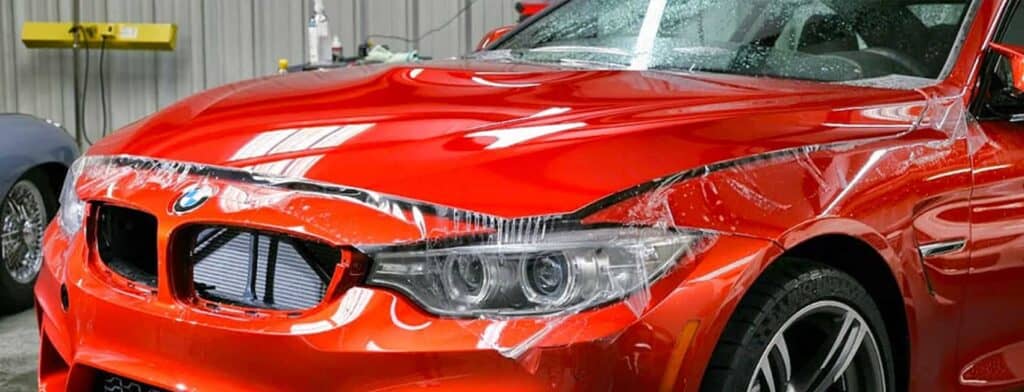
PPF also has self-healing properties, that even minor scratches and swirl marks quickly disappear when exposed to heat. Meanwhile, PPF is also a fitting protection against UV rays from the sun.
Advantages and Disadvantages of PPF
While you already know that Paint Protection Film makes a considerable difference in the longevity of keeping your car a flawless paint job, you should still know its pros and cons (especially when comparing it to Ceramic Coating).
Here are the advantages of using Paint Protection Film (PPF):
-
Transparent and Invisible: The PPF’s material is made of a thin and transparent layer of film, which is hardly noticeable when applied correctly to your car. So it does not affect your paint’s physical appearance.
-
Hydrophobic Properties: Liquids and contaminants like dirty water, mud, oil, and smudges will bead up and run off your car’s paint because of the film’s hydrophobic properties.
-
Protects Original Paintwork: Aside from being hydrophobic, PPF can also protect your car’s paintwork from scratches, rock chips, and insect stains, making it look fresh and new longer.
-
Easy to Clean and Maintain: PPF requires no special skills to keep it in good condition. There are even available products on Avalon King that you can use when cleaning your vehicle to avoid damaging the PPF.
-
Self Healing: High-grade brands of PPF can heal on their own. It is made of elastomeric polymers, which can automatically fix small swirls when applied with heat.
- Multiple Finish Options (Matte, Gloss): You are free to customize the PPF based on your preference since there is an option to use Matte or Gloss PPF. Each type will give your vehicle a different look but with the same protective properties.
On the other hand, the potential drawbacks that you should be aware of when using PPF are:
-
Cost of application: From the material to the installation of the Paint Protection Film, the amount you have to pay upfront is costly. It will also vary significantly on the size and complexity of your vehicle.
-
Possibility of incorrect application: There is a chance that the Paint Protection Film will incorrectly work if it’s not smoothly applied across the entire surface. To avoid this, you should look for a reliable vendor who can also provide efficient applications.
-
Some films turn yellow over time: Some PPFs degrade and turn yellow over time because of UV exposure, especially if you purchase a low-quality film protector. We use modern and newer materials on Avalon King to avoid this defect.
- Needs to be replaced: After 5, 10, or 15 years, you must replace your PPF since the film's integrity cannot be guaranteed. While some PPF feature warranties, you’ll still need to pay for replacement services.
Overview of Ceramic Coating
If you are thinking about applying a ceramic coating to your car, it’s more than making it look lovely all the time. Ceramic coating is also protective, preventing dirt and grime from sticking to your vehicle.
Let’s look at the basics and help you decide which is better: PPF or ceramic coating.
What is ceramic coating?
Ceramic coating, also known as nano-ceramic coating, is another kind of protection applied to the exterior of a car. It is a liquid polymer solution that blends with your car's paint, creating an additional hydrophobic layer of protection.
Initially, Ceramic Coating is only available to be applied by professional service providers. However, with the fast-growing car technology, it is now available widely, more affordably, and quickly.
In fact, Avalon King offers a few DIY Ceramic Coating Kits, including Armor Shield IX DIY Ceramic Coating Kit and Armor Shield Lite.

What does ceramic coating do?
The ceramic coating acts as a second layer of your car exterior. It uses nanotechnology, which are tiny particles that come together to form a very thin, invisible layer to the eye.
This transparent layer seals the pores on your car’s paint, making it resistant to ultraviolet rays, scratches, chemicals, and extreme heat. It also makes your car shiny and maintains your vehicle's original paint for a more extended period.
Moreover, ceramic coating is not only for paint protection, but you can also apply it to wheels, brake calipers, and even glass for extra protection.
Advantages of ceramic coating
We’ve already mentioned above the primary purpose of using Ceramic Coating. Besides the obvious, below are a few more advantages to using and applying Ceramic Coating on your car.
-
Less Expensive Alternative: In some cases, ceramic coating is used as an alternative to a PPF because it is less expensive. You can get it done at a service center or DIY at home.
-
Gloss Enhancement: Ceramic coating is your best bet if you are a fan of shiny cars! Aside from protecting your vehicle’s paint, it leaves a fresh coating, bringing out the best of the original paint job.
-
Hydrophobic Nature: Ceramic coating is made of hydrophobic materials, which can easily repel water. So, all water-based dirt and grime will easily bead on the surface and eventually slide off. Such nature can also help with easier and quicker cleaning.
-
Lasts Longer: Compared to other paint coatings (i.e., wax), ceramic coating is expected to last for years with correct maintenance. Also, it will not quickly wear off even after being exposed to weather and other atmosphere components.
- Requires Less Maintenance: There are a lot of post-installation materials that you can easily use to maintain the ceramic coating, such as the Ceramic Maintenance Shampoo.
What is the downside to ceramic coating?
Every product has its drawbacks, and there are things that ceramic coating cannot do. These downsides will be deal breakers when deciding between using Ceramic Coating vs PPF.
Here are a few disadvantages when using Ceramic Coating:
-
Limited Protection: Ceramic Coating does not protect your vehicle from rock chips, scuffs, etc, but only helps prevent it from water stains, UV, and scratches.
-
Labor-Intensive Paint Preparation: The application requires labor-intensive paint preparation for the ceramic coating to work. This is due to ceramic coatings needing the surface to be pristine to maximize their protective properties.
- Difficult to Remove: When applied to your vehicle, removing it may require abrasive methods that may lead to damaging the paint on your car.
What is Similar Between Ceramic Coating and PPF?
If you’ve used car wax and polish to protect your daily driver or garage queen, and looking for a significant upgrade, a ceramic coating or PPF will exceed your expectations.
Although these two products are significantly different in their construction, they are quite similar in the protection attributes they deliver. It is a good idea to complete paint correction and some prep work before applying either.
Here are four items that nano-coatings and PPF share.
Protects Against Exposure to Harsh Elements

A leading source of paint damage is ultra-violet light or UV rays. Excessive heat, acid rain, even smog contains harsh contaminants that slowly eat away at the paint’s clear coating – if it’s not protected. This is the job of a paint protection film and a nano-ceramic coating.
A ceramic coating hardens on the clear coat surface on the entire car and produces a very strong glass shield that blocks UV rays, acid rain, smog, snow, and ice from attaching to the paint surface. A PPF does the same job but is a much softer material.
Prevents Paint Fading
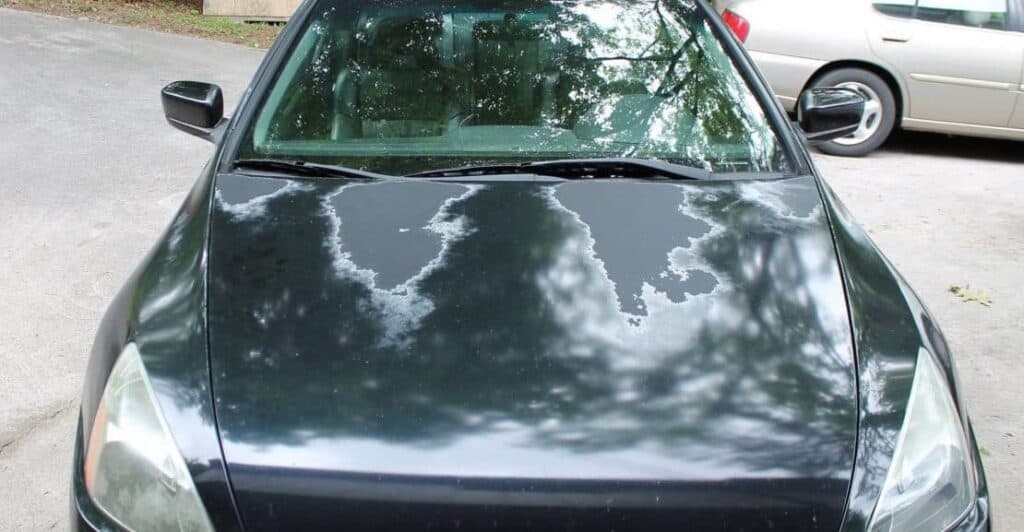
The car’s paint will begin to fade when the clear coating is damaged. The leading source of this is UV light, chemicals, and acids. A PPF is made from a durable material (thermoplastic urethane) that is resistant to these harmful contaminants – and can hold its integrity for up to 10 years.
Likewise, the ceramic automotive paint protection coating is made up of SiO2 or Silica Dioxide. SiO2 is an inorganic metal oxide that has a diameter smaller than 100 nanometers. When it hardens and is buffed off the surface after being applied, it produces a crystal layer onto the surface area.
The higher your SiO2 percentage, the harder and longer-lasting. Most of the top contending DIY ceramic coatings have SiO2 percentages around 70 percent – the cream of the crop is above 80%, but less than 90%, like the really high SiO2 coatings are hard to apply.
Keeps Paint Looking Fresh and Clean

Before you install a PPF or nano-coating, it is recommended to polish the paint and clear coat factory paint underneath.
This helps to produce amazing shine. Since a coating hardens as glass, it amplifies the undercoat brilliance of freshly polished paint. PPF likewise helps to keep the bad stuff from penetrating, keeping the paint looking clean and fresh for years.
Blocks Swirl Marks or Chemical Stains

One of the drawbacks of using wax, polish or even paint sealants, is that the potential for tiny scratches or swirl marks still exists. Swirl marks occur when the car is washed, waxed, or polished with materials in a circular motion (like we’re all taught).
What happens is that dirt, debris, or microscopic imperfections in the materials will grind into the clear coat. As you literally grind the debris into the clear coat (in a circular motion) it causes scratching to occur. Both paint protection film and a durable ceramic coating will prevent this from occurring. The result is cleaner, fresher, longer-lasting paint.
Comparing PPF and Ceramic Coating
While there is no straight answer to the question of what's better, Ceramic Coating vs Paint Protection Film (PPF), it will all boil down to personal needs and preferences.
To help you fully understand the differences, let us compare them using a few points below.
Aesthetic Appeal
Paint Protection Film (PPF): When applied, Paint Protection Film is clear and transparent but is more noticeable due to its thicker nature. You also have the option to use either a matte or glossy PPF, depending on your preference.
Ceramic Coating: If you want an invisible shield while enhancing the original look of your vehicle’s paint, Ceramic Coating is the best choice. It has a candy-gloss-like finish that does not alter the look of your car.
Maintenance
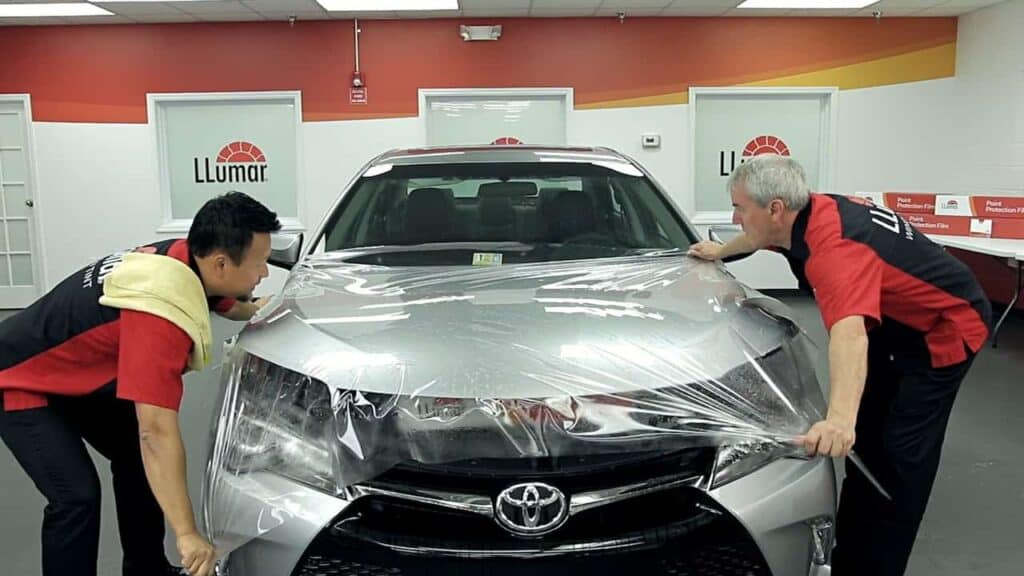
Paint Protection Film (PPF): Regarding upkeep, PPF requires more attention to maintain its optimal appearance. You will need to clean it regularly and, at the same time, be mindful of its edges and seams to ensure it is kept in place.
Ceramic Coating: Conversely, ceramic coating requires less maintenance because of its smooth hydrophobic surface. A simple wash is often all it takes, with the help of pre-installation and post-installation ceramic shampoo.
Level of protection

Paint Protection Film (PPF): PPF has a thick structure that is a physical barrier against everyday hazards like rock chips, chemical stains, and UV rays. You can even compare it to an invisible shield that can absorb impact, especially since it has a self-healing component.
Ceramic Coating: Boasting a different kind of protection, Ceramic Coating is a liquid solution that acts as a repellant to environmental contaminants and harsh chemicals. It does not have the power to absorb impacts like PPF, but it can also act as a robust chemical defense solution.
Which provides better protection against scratches, rock chips, etc.?
If we compare Paint Protection Film (PPF) and Ceramic coating in terms of protection against scratches, rock chips, and other hazards, PPF is better.
As mentioned, PPF is designed to absorb impact, minimizing damage from falling debris, rocks, and harmful chips. Plus, its self-healing and hydrophobic properties help maintain its longevity.
Cost Comparison
Paint Protection Film (PPF): Paint Protection Film is generally more expensive than Ceramic Coatings. It can vary based on the quality and the size of your car and can range from $600 or more. Take note that this still needs to include installation and maintenance.
Ceramic Coating: Ceramic Coating is a more budget-friendly option compared to PPF. Depending on the brand and quality of your product, you can easily save money by re-applying it for a few years. Avalon King’s DIY Ceramic Coating Kit starts at $74.99 and can already last for two years.
Longevity: Lifespan and Durability

Paint Protection Film (PPF): A high-quality PPF can last at least 5 to 15 years of protection when professionally applied and regularly maintained. So, choosing the correct product and service provider who will use the PPF for your vehicle is essential.
Ceramic Coating: While it offers durability, it may only last around two years and require reapplication for optimal performance. You can think of this as a touch-up to keep it well-maintained.
Which One is Best for Your Car?

Making the decision as to whether to install ceramic coatings or a PPF really breaks down to two items – your budget and your needs. If you’re looking to improve the shine of your paint and reduce the need to wash the vehicle every week, then the ceramic coating segment is best for you.
If you drive on country roads or highways frequently and want to protect the paint from rock chips, and other road debris that can penetrate a ceramic coating, then PPF is your best bet.
With regard to cost – PPF is far and away from the most expensive paint protection product to use. It’s always installed by a professional, and in most cases, can cost up to $5,000 to apply to the entire vehicle.
A ceramic coating can be completed by yourself (with some prep work required). You can complete a DIY ceramic coating installation for about $600 (including materials needed for prep and continual car care).
The Benefits of Applying Ceramic Coating Over a PPF

So, you want the best of both worlds? Consider using both – but in a strategic way. The majority of PPF owners will only have this material applied to the front bumper or grill area, fenders, the hood, and side-view mirrors.
This is done to protect the high-exposed areas from rock chips and other small debris damage. They will then use a ceramic coating or other paint protection product on the other exposed areas of their vehicle.
However, if you’re looking for the ultimate layer of protection, consider applying a DIY-Ceramic Coating as a top coat of a PPF. Ceramic coatings will stick to a PPF. When you go with this extra effort, you’ll be able to improve a few of the drawbacks of PPF-only protection.
Improves the hydrophobic properties
We mentioned that one of the drawbacks of the paint protection film is the lack of hydrophobic properties. This results in enhanced water spots, but also tends to cause dirt and debris to stick to the PPF. By applying a ceramic coating, you’ll reverse this attribute and turn it into a positive feature.
Enhances self-cleaning
When dirt and debris have a hard time sticking to the PPF and ceramic coating, you’ll spend less time cleaning or washing the car. This helps to improve the car care of PPF materials and will improve the cleanliness of your vehicle.
Reduces Fade
PPF is also notorious for yellowing, fading or becoming discolored due to excessive exposure to UV light. The application of a ceramic coating provides a microscopic layer of sunblock to extend the life of many paint protection films.
As you can see, choosing a ceramic coating or a PPF to keep your vehicle paint protected is a smart idea. If cost is your main concern, then you should probably opt for a ceramic coating. However, if you’re looking for the ultimate protection possible, consider using both.
Frequently Asked Questions (FAQs)
Let us answer below some of the most Frequently Asked Questions about PPF versus Ceramic Coating.
Can you put PPF over ceramic coating?
You cannot put PPF over ceramic coating since it won’t stick properly. While other people say they have done it, the durability and effectiveness of this are not proven. One of the properties of high-quality Ceramic Coating is to make the surface of your vehicle slick, so PPF should not be able to stick to it.
Do I need PPF and ceramic coating?
If you are a car owner who wants to protect your vehicle's original exterior because of everyday use, then you need a PPF or ceramic coating. You can consider either of the two, depending on your preference and budget, but you can also choose to get both.
Is PPF and ceramic coating worth it?
The decision to invest in Paint Protection Film (PPF) or Ceramic Coating depends on a few factors, including lifestyle, budget, and long-term maintenance. If you want to keep your car’s value for a long time, maintain its appearance, and prevent it from everyday hazards, then getting PPF and ceramic coating is worth it.





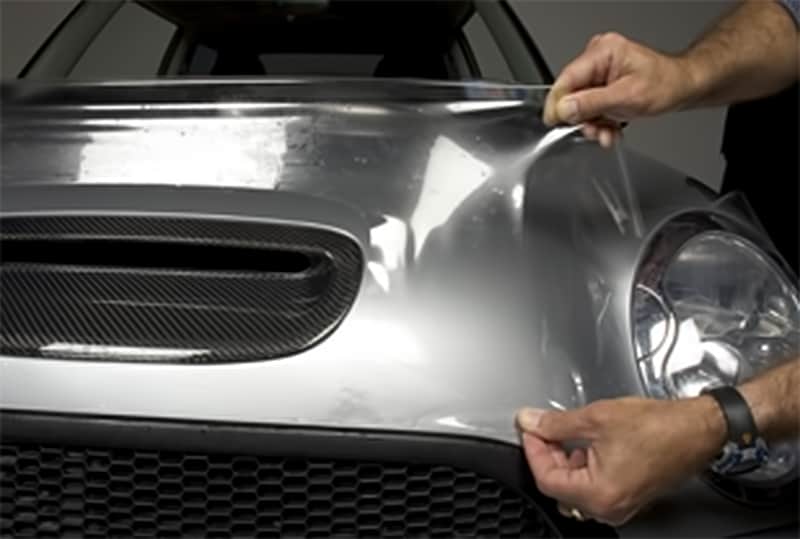




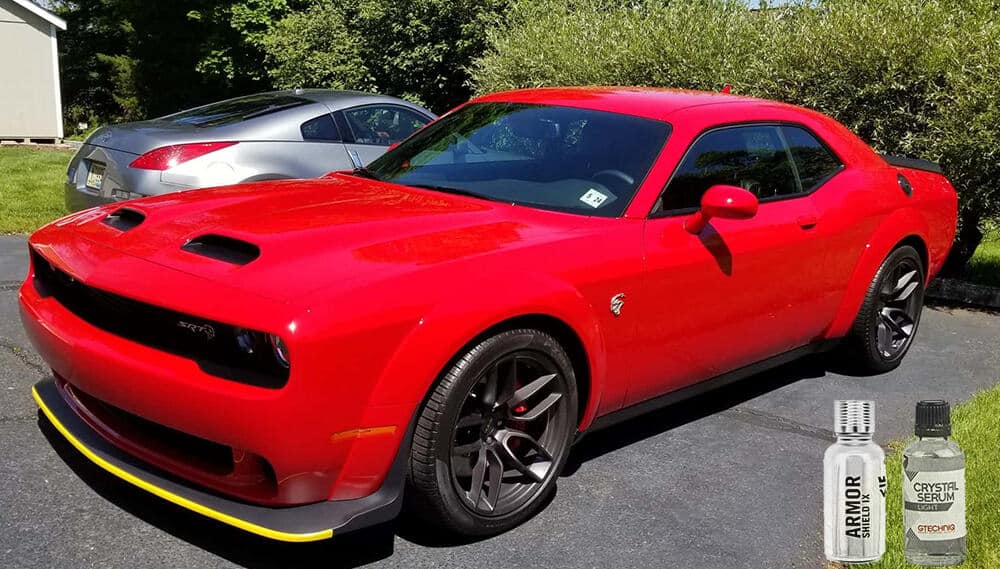
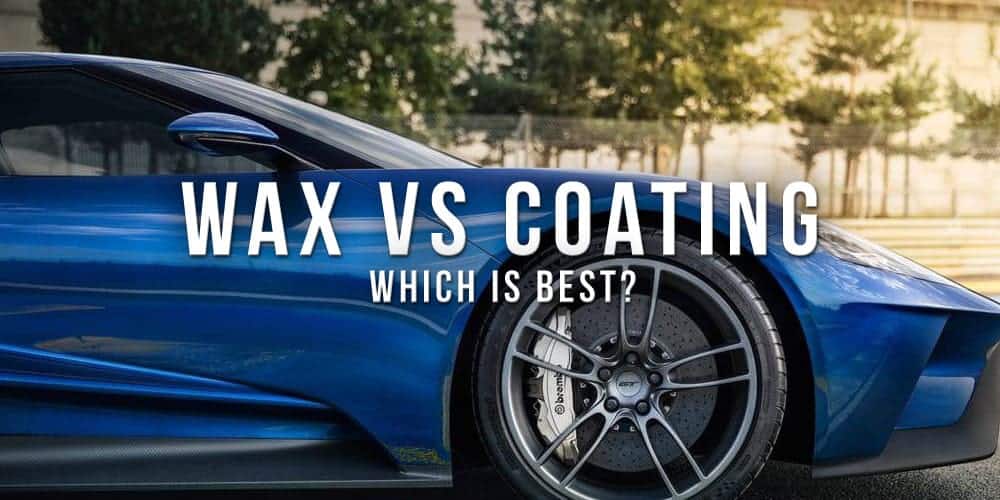

26 comments
Eric Williams
Yeah, you can apply on top of almost any PPF (you can’t only if they have some sort of a special hybrid or wax coat on top, very rare out of the box). And that is pretty much the best thing you can do in protecting your vehicle as you get the supreme surface properties of the ceramic coat with the additional physical protection beneath from the PPF.
Yeah, you can apply on top of almost any PPF (you can’t only if they have some sort of a special hybrid or wax coat on top, very rare out of the box). And that is pretty much the best thing you can do in protecting your vehicle as you get the supreme surface properties of the ceramic coat with the additional physical protection beneath from the PPF.
TheMBOD
Thanks for a great article but I am still unsure. Are you saying you can apply a ceramic coating ON TOP of the PPF?
Thanks for a great article but I am still unsure. Are you saying you can apply a ceramic coating ON TOP of the PPF?
Tim Charlet
Hi Sergey:
Thanks for the question. Yes – according to US, it’s completely safe and OK to apply Armor Shield IX to the top of a PPF. However, you might want to confirm this with the manufacturer or your PPF – as it might void your warranty (if you have one). But, we’ve found ZERO negative side-effects to doing so.
Hi Sergey:
Thanks for the question. Yes – according to US, it’s completely safe and OK to apply Armor Shield IX to the top of a PPF. However, you might want to confirm this with the manufacturer or your PPF – as it might void your warranty (if you have one). But, we’ve found ZERO negative side-effects to doing so.
Sergey
Just to confirm. It is safe to apply Armor Shield IX coating on top of PPF like Xpel and such, correct?
Thanks
Just to confirm. It is safe to apply Armor Shield IX coating on top of PPF like Xpel and such, correct?
Thanks
Tim Charlet
Hi Gerald:
Thanks for contacting us. Good to see more readers from Arizona (my home state). The shop is accurate, as anything more than (2) coats are pretty much just a waste of money and time. You can apply a single coat, but you’ll get longer-lasting protection, (especially in extreme heat) with a 2nd coat.
Hi Gerald:
Thanks for contacting us. Good to see more readers from Arizona (my home state). The shop is accurate, as anything more than (2) coats are pretty much just a waste of money and time. You can apply a single coat, but you’ll get longer-lasting protection, (especially in extreme heat) with a 2nd coat.
gerald B gilbert
I want to know how many coates of ceramic(nano) a tuscon shop says the most is 2.
so never just 1 ?
how many
I want to know how many coates of ceramic(nano) a tuscon shop says the most is 2.
so never just 1 ?
how many